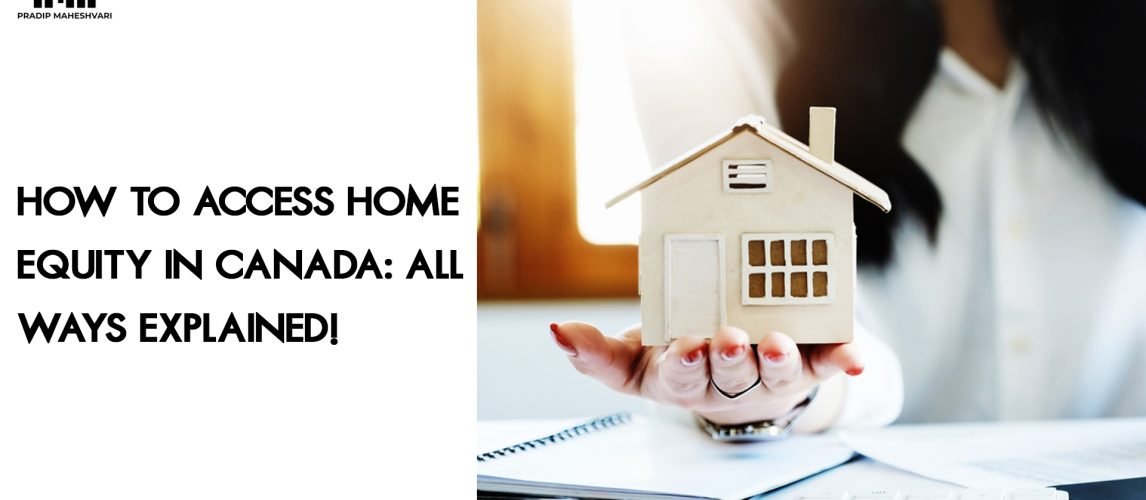Home equity can be a valuable financial resource, offering homeowners the opportunity to fund major expenses, consolidate debt, or invest in new ventures. If you’re wondering how to access home equity in Canada, this guide will explain the options available and help you determine the best approach for your financial needs.
Here’s a step-by-step guide by Pradip Maheshvari Mortgages to explore all the ways to access your home equity so you can confidently make informed decisions.
Accessing Home Equity: Best Options Explained!
1. Home Equity Line of Credit (HELOC)
A HELOC is a revolving line of credit secured against your home. It allows you to borrow funds as needed, similar to a credit card, with the added advantage of lower interest rates.
Why Choose a HELOC?
- Flexible borrowing: Use funds only when required.
- Interest savings: Pay interest only on the amount used.
- Reusability: Borrow and repay as often as needed within the approved limit.
Ideal For:
Renovations, emergency funds, or ongoing expenses.
2. Mortgage Refinancing
Refinancing your mortgage involves replacing your existing mortgage with a new one that has updated terms. This option allows you to access up to 80% of your home’s appraised value (minus the remaining mortgage).
Benefits of Mortgage Refinancing:
- Lower interest rates: Reduce monthly payments by securing a better rate.
- Lump sum access: Obtain a significant amount of funds upfront.
- Debt consolidation: Pay off high-interest debts.
Ideal For:
Large expenses like education, debt repayment, or investment opportunities.
Read More: Refinancing Your Mortgage: When and Why It Makes Sense?
3. Equity Takeout Loans
An equity takeout loan lets you borrow a lump sum against the equity in your home. Unlike a HELOC, this is a one-time loan with a fixed repayment schedule.
Why Consider Equity Takeout?
- Predictable payments: Fixed loan terms.
- Access to substantial funds: Perfect for significant investments.
Ideal For:
Purchasing rental properties or funding business ventures.
Read Also: Equity Take Out vs. Mortgage Refinancing: What’s Your Take?
4. Reverse Mortgages
A reverse mortgage is designed for homeowners aged 55 and older. It allows you to access a portion of your home equity without selling your home. The loan is repaid when the home is sold, or the homeowner moves out.
Advantages of Reverse Mortgages:
- No monthly payments: Funds are repaid at the end of the term.
- Stay in your home: Maintain ownership while accessing cash.
Ideal For:
Retirees looking to supplement their income or cover living expenses.
5. Second Mortgages
A second mortgage involves taking out an additional loan secured against your home equity. This is typically a fixed loan with higher interest rates than your primary mortgage.
Why Consider a Second Mortgage?
- Access funds without altering your first mortgage.
- Short-term solution for immediate needs.
Ideal For:
Emergency expenses or high-impact home renovations.
Borrowing Against Home Equity: Which Option Is Right for You?
Choosing the best way to access your home equity depends on your financial objectives, credit profile, and repayment capacity. For example:
- HELOCs offer flexibility.
- Mortgage refinancing works well for debt consolidation or securing better terms.
- Reverse mortgages cater specifically to retirees.
Helpful Resources
Learn how to leverage your home equity effectively by reading our blog:
Five Best Ways to Use Home Equity in Canada
Conclusion:
Accessing home equity can open doors to financial opportunities, but the key is to choose the right method for your goals. At Pradip Maheshvari Mortgages, we specialize in guiding homeowners through tailored solutions like HELOCs, mortgage refinancing, and equity takeout loans.
Take the next step confidently with personalized advice.


No comment yet, add your voice below!